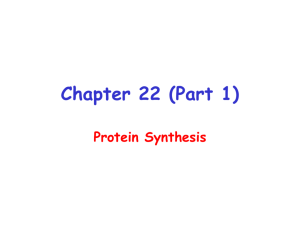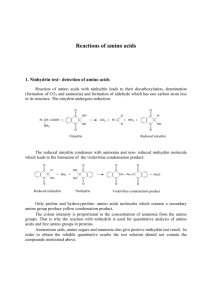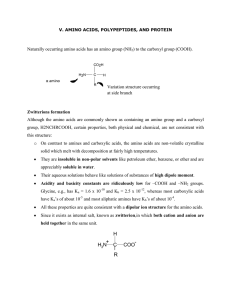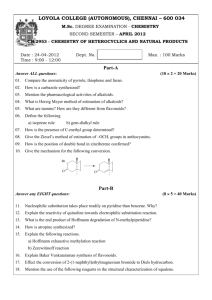ELECTIVE II- CHEMISTRY OF BIOMOLECULES
advertisement
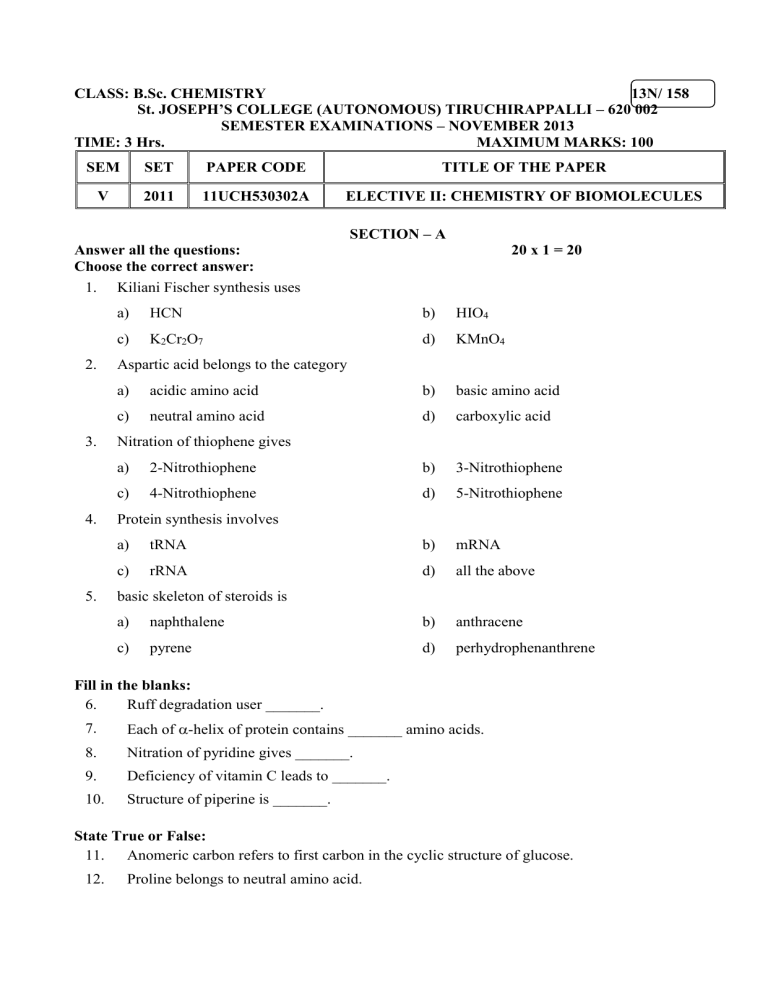
CLASS: B.Sc. CHEMISTRY 13N/ 158 St. JOSEPH’S COLLEGE (AUTONOMOUS) TIRUCHIRAPPALLI – 620 002 SEMESTER EXAMINATIONS – NOVEMBER 2013 TIME: 3 Hrs. MAXIMUM MARKS: 100 SEM SET PAPER CODE TITLE OF THE PAPER V 2011 11UCH530302A ELECTIVE II: CHEMISTRY OF BIOMOLECULES SECTION – A Answer all the questions: Choose the correct answer: 1. Kiliani Fischer synthesis uses 2. 3. 4. 5. 20 x 1 = 20 a) HCN b) HIO4 c) K2Cr2O7 d) KMnO4 Aspartic acid belongs to the category a) acidic amino acid b) basic amino acid c) neutral amino acid d) carboxylic acid Nitration of thiophene gives a) 2-Nitrothiophene b) 3-Nitrothiophene c) 4-Nitrothiophene d) 5-Nitrothiophene Protein synthesis involves a) tRNA b) mRNA c) rRNA d) all the above basic skeleton of steroids is a) naphthalene b) anthracene c) pyrene d) perhydrophenanthrene Fill in the blanks: 6. Ruff degradation user _______. 7. Each of -helix of protein contains _______ amino acids. 8. Nitration of pyridine gives _______. 9. Deficiency of vitamin C leads to _______. 10. Structure of piperine is _______. State True or False: 11. Anomeric carbon refers to first carbon in the cyclic structure of glucose. 12. Proline belongs to neutral amino acid. 13. Quinoline upon treatment with tin and hydrochloric acid gives quinoline – N – oxide. 14. Antipyretics are used to treat hypertension. 15. Abietic acid is a diterpene. Match the following: 16. Maltose - a) male sexhormone 17. Gabriel phthalimide synthesis - b) tRNA 18. Gramine - c) amino acid 19. Clover leaf model - d) 1,4glycosidic linkage 20. Androgen - e) 3-Dimethylamino – methylindole SECTION – B Answer all the questions: 21. a. Write a note on mutarotation. 5 x 4 = 20 OR 22. b. Discuss the structure and properties of cellulose. a. Write any two methods of preparation of amino acids. OR 23. b. Discuss N-terminal analysis by Edman Pehr method. a. Discuss the preparation and properties of furan. OR 24. b. Write the chemical properties of pyridine. a. Define nucleotide and nucleoside. Write the types of nucleic acids. OR 25. b. Draw the structure and functions of chloramphenicol. a. Write the functions of estrogen. OR b. Discuss the classification of terpenes. Write isoprene rule. SECTION – C Answer any FOUR questions: 26. a) Derive the structure of glucose. b) Discuss the interconversion of ketose to aldose. 27. 4 x 15 = 60 (10) (5) a) Discuss the primary, secondary, tertiary structure of proteins. b) Complete the following: (12+3) (i) H2NCH2 COOH + NaOH ? (ii) H2NCH2 COOH + Ba (OH)2 (iii)H2NCH2COOH + HNO2 ? ? 28. Discuss the preparation, structure, physical and chemical properties of indole. Write the uses. 29. Write the structure and functions of a) DNA b) Write the types of RNA (3) 30. (12) a) Discuss the structural elucidation of geraniol. b) Discuss the structural elucidation of piperine. ************** (10) (5)








